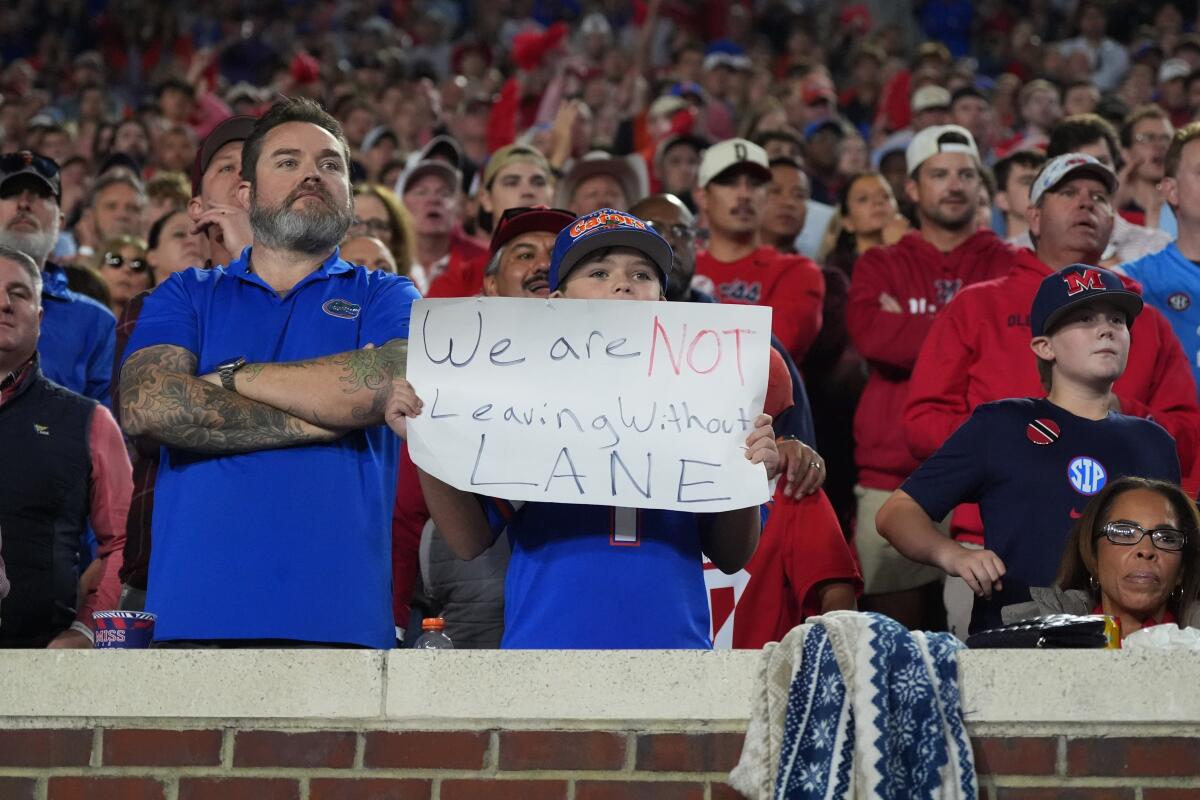How Pete Carroll helped Lane Kiffin choose LSU over Ole Miss
Lane Kiffin has left Mississippi to become the new coach at Louisiana State. But not before getting some key advice from his former USC boss, he has revealed. Key advice that also came indirectly from his late father.
More than two decades ago, Kiffin helped USC win two national championships as an assistant coach under Pete Carroll.
And long before that, Carroll and Kiffin’s father, renowned defensive coach Monte Kiffin, worked together on several coaching staffs at the college and NFL levels.
Kiffin has said that he wished his father, who died last year at age 84, was around to advise him as he struggled with the decision over his latest career move.
On Sunday just before boarding a private jet from Oxford, Miss., to Baton Rogue, La., Kiffin said he ended up receiving that fatherly advice from his former mentor, current Las Vegas Raiders coach Carroll.
“Coach Carroll said, ‘Your dad would tell you to go, man, take the shot,’” Kiffin said to ESPN’s Marty Smith. “‘Take the shot. You accomplished a lot here.’”
Kiffin was 55-19 in six seasons at Ole Miss, including an 11-1 record and an expected invite to the College Football Playoff this season. While Kiffin has said he had hoped to continue coaching the Rebels in the postseason, defensive coordinator Pete Golding will serve as head coach going forward.
Carroll and Monte Kiffin were both members of the Arkansas coaching staff in 1977 (two years after Lane Kiffin was born) — Carroll as a graduate assistant and the elder Kiffin as defensive coordinator. Monte Kiffin’s only head coaching job was at North Carolina State from 1980 to 1982, and Carroll was his defensive coordinator all three seasons.
Their careers would cross paths from 1984 to 1990 on the coaching staffs of the Buffalo Bills, Minnesota Vikings and New York Jets. One of the architects of the successful “Tampa 2 defense,” Monte Kiffin achieved his greatest notoriety as defensive coordinator of the Tampa Bay Buccaneers from 1996 to 2008, winning a Super Bowl following the 2002 season.
“Of all the great coaches I have worked with, none would have a more fundamental impact on the tactical side of my coaching than Monte Kiffin,” Carroll wrote in his 2010 book, “Win Forever.”
Carroll added: “His great contribution to my career, however, came early on — long before I ever entered the NFL— when he impressed upon me a simple but powerful belief: ‘In order to be successful, you must have a consistent philosophy. If you change who you are from year to year,’” he explained, ‘you’re never going to be great at anything.’”

Monte Kiffin, left, served as son Lane Kiffin’s defensive coordinator at USC from 2010 to 2012.
(Allen Schaben / Los Angeles Times)
In his first season as USC coach in 2001, Carroll hired Lane Kiffin as his tight ends coach. Kiffin was promoted to receivers coach in 2002 and eventually had passing game coordinator, recruiting coordinator and offensive coordinator added to his duties before leaving after the 2006 season.
After two seasons as head coach of the Oakland Raiders and one as head coach at Tennessee, Kiffin returned to USC to replace Carroll, who had taken the job as coach of the Seattle Seahawks. Kiffin was 28-15 with the Trojans. He was fired five games into his fourth season, hours after a lopsided loss to Arizona State.
Kiffin went on to become an assistant on coach Nick Saban‘s staff at Alabama before head coaching stints at Florida Atlantic and Mississippi. On many of his coaching stops, Kiffin hired his father as part of his staff, including at Tennessee and USC as defensive coordinator, Florida Atlantic as a defensive assistant and Mississippi as a player personnel analyst.
On Saturday, as he weighed his options between Mississippi and LSU, Kiffin took to X and posted a photo featuring a sketch of his father giving a thumbs-up sign.
“Wish I could hug you right now and you could guide me,” Kiffin wrote to his dad. “Love ya.”
In a way, Monte Kiffin did end up providing guidance. Kiffin told Smith that he thought back to his father’s funeral and all the people that reached out “from around all those different spots — N.C. State, all the different spots he coached.”
“They said he was able to impact them and how much that meant to them,” Kiffin said. “And so I’ve really strived since that day to really try to impact people and help people through life, through my journey. So I just prayed a lot and made a family decision and hopefully get a chance to go, you know, impact a whole new set of people.”


